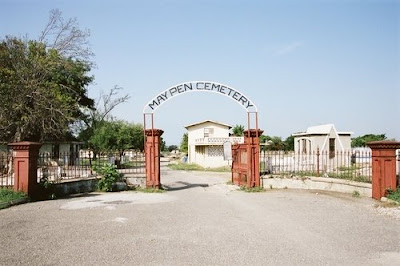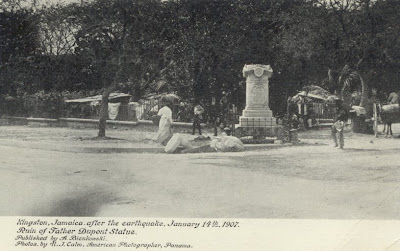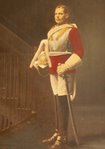I've been remiss in updating my blog for the past month. I've been spending time working on a presentation for a recent conference, African Roots in Canada, organized by the Toronto Branch of the Ontario Genealogical Society in cooperation with the Ontario Black History Society and the Toronto Public Library. The conference took place last Saturday, August 9th, 2008, at the North York Central Library, and was well attended with about 75 people registered. My part in this first-time conference was a presentation on Researching Your Jamaican Ancestry from Canada. At the end of my presentation I showed slides of a few records from my Brown ancestry. It occurs to me that I wrote one post, back on April 1st, 2008, about the Browns, but never followed up on them even though I indicated I would. So I thought I might expand on the Brown family to the best of my ability, showing some of the records I've come across in my research.As I wrote in the earlier post, the Brown family came from Port Royal. I do not know for sure exactly where they lived there, but it could have been on a street similar to this one.
As I have already written, my great-grandfather, Daniel Elias Brown, was a shipwright, employed at the Port Royal Dockyard. I have not, so far, been able to find out much about his parents. He was born in Kingston 25 February 1827, on King Street, the son of Edward and Sarah Brown, and baptized on 3 May 1827. I have no further information on his parents, except that they had three other children, that I've found -- a daughter, Sarah Saunders Brown, born 24 December 1828 in Pink Lane, Kingston,and baptized in April 1828; another daughter, Eliza, born 9 May 1832 in Princes Street, Kingston, and a son, Jonas, born 25 August 1834, also in Princes Street. Both Eliza and Jonas were baptized 8 January 1837.
So, as I've indicated in my title, this is not just the story of the Brown family. Unable to find out more about Daniel's parents' origins, I moved to his wife's family. Daniel married a widow, Sarah Letitia McDonald. Sarah had married one Donald McDonald, a shoemaker in Port Royal, in 1851 in Port Royal. They were married in the Wesleyan Methodist Church by the Rev. William Tyson. This marriage record, part of the Dissenter Marriage Registers microfilmed by the Mormons, does not give the ages or names of parents of the parties, though it does indicate that permission was given for the bride to be married by her mother, "Mary Smith, surviving parent", whereas the groom was listed as being of "full age". By that we can deduce that Donald was over 21 and Sarah was not. Sarah's full name was given as Sarah Letitia Huggins, and I discovered in my research that her parents were James Vashon Huggins and Mary Goldson, both of Port Royal. By this time James Huggins was dead and Mary Huggins had remarried in 1845 to George Pitblade Smith.
Donald and Sarah had two daughters, Elizabeth Huggins McDonald, born 1852, and Mary Noel, born 1854. I have so far been unable to find a burial record in Port Royal for Donald McDonald, who must have died prior to 1858 when Sarah married Daniel Elias Brown. Here is the record of their marriage, from the Dissenter Marriage Registers for Port Royal:
 This marriage also took place in the Wesleyan Methodist denomination; the officiating minister was the Rev. James Cox, another person who fits into my family research, though again, I have been unable to find out much about him except for a small entry in Philip Wright's Monumental Inscriptions of Jamaica, published by the Society of Genealogists in 1966. According to a mural tablet in the Wesley Church, Tower Street, "the Rev. James Cox died at Morant Bay, 30 May 1859, aged 55", apparently not too long after he married Daniel and Sarah. In corresponding with another Cox researcher I have learned that James Cox may have been born in Bermuda. He settled in Jamaica, married and fathered two sons that I know of: Theophilus Pugh Cox, born about 1844, who became the Headmaster of the Government Training College, Spanish Town, and Henry Martyn Hill Cox, born about 1845, who also became a Methodist minister. These brothers married two sisters, Mary Ann Barned and Lucinda Baker Barned, respectively.
This marriage also took place in the Wesleyan Methodist denomination; the officiating minister was the Rev. James Cox, another person who fits into my family research, though again, I have been unable to find out much about him except for a small entry in Philip Wright's Monumental Inscriptions of Jamaica, published by the Society of Genealogists in 1966. According to a mural tablet in the Wesley Church, Tower Street, "the Rev. James Cox died at Morant Bay, 30 May 1859, aged 55", apparently not too long after he married Daniel and Sarah. In corresponding with another Cox researcher I have learned that James Cox may have been born in Bermuda. He settled in Jamaica, married and fathered two sons that I know of: Theophilus Pugh Cox, born about 1844, who became the Headmaster of the Government Training College, Spanish Town, and Henry Martyn Hill Cox, born about 1845, who also became a Methodist minister. These brothers married two sisters, Mary Ann Barned and Lucinda Baker Barned, respectively.
Daniel, in marrying Sarah, took on her two daughters who would have been six and four years old, and not long after began a family of his own, seven children in all, six daughters and a son. All were born in Port Royal and baptized there in the Wesleyan Methodist church. I have written about some of them in previous posts -- Susan Saunders Brown who married John Cassis; my grandmother, Amanda, who married William Dey Smedmore; Bertha Rose who married Charles Percival Esterine and emigrated to New York; and Theresa Eugenie, who never married. It appears that, like the Smedmore family, the Brown family also left Port Royal at some point to settle in Kingston, since Daniel Elias Brown died there 7 April 1891, at 115 East Street. His death was registered by his daughter, Sarah Letitia Webster Brown, whose address was given as 49 Rose Lane, and that is where Sarah, Daniel's widow, died 25 July 1898. Perhaps Daniel and Sarah had lived at 115 East Street and after he died she went to live with her unmarried daughter, Sarah, who had been named after her.
In my next post I will pursue the story of Sarah Letitia Brown, my great-grandmother and her family history.

 This cemetery, one of the oldest public cemeteries, has become very rundown and neglected, but efforts have been made within the past two years at cleaning it up. As far as I know this cemetery has not been recorded.
This cemetery, one of the oldest public cemeteries, has become very rundown and neglected, but efforts have been made within the past two years at cleaning it up. As far as I know this cemetery has not been recorded. where higglers have set up shop. Similarly, I am told one should not wander through the churchyard of St. Andrew Parish Church, Half-way Tree without an escort!
where higglers have set up shop. Similarly, I am told one should not wander through the churchyard of St. Andrew Parish Church, Half-way Tree without an escort! Donald Lindo has collected over 7000 burial records of St. Andrew Parish Church covering 1657 to 2000, and these can be found on his CD, Genealogy of Jamaica, 2006. Thanks also to Donald I have a photograph of the grave of my Great uncle, Joseph Rodrigues Da Costa, who is buried in Calvary Roman Catholic Cemetery.
Donald Lindo has collected over 7000 burial records of St. Andrew Parish Church covering 1657 to 2000, and these can be found on his CD, Genealogy of Jamaica, 2006. Thanks also to Donald I have a photograph of the grave of my Great uncle, Joseph Rodrigues Da Costa, who is buried in Calvary Roman Catholic Cemetery. 






+on+SS+Coronado+August+1915.jpg)














































